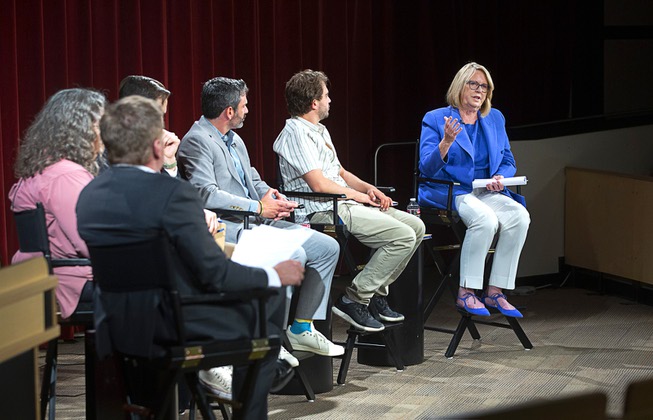
Ellen Whittemore, far right, executive vice president, general counsel and secretary for Wynn Resorts, responds to a question about homelessness in Las Vegas during a roundtable discussion at Greenspun College of Urban Affairs at UNLV Wednesday, May 17, 2023. The panel discussion was sponsored by Nevada Women’s Philanthropy.
Thursday, May 18, 2023 | 2 a.m.
The homeless crisis in Western cities has a scope of challenges that require dense cooperation between various nonprofits, government, health care, service providers and business interests, according to a UNLV roundtable discussion on the topic Wednesday organized and sponsored by Nevada Women’s Philanthropy.
UNLV social work professor Nicholas Barr, who specializes in youth and veteran homelessness, estimates there are 5,645 homeless people living in Clark County.
That number, however, is likely a vast undercount of those in the valley considered “housing unstable” — those who might stay with someone a few days at a time before finding another dwelling elsewhere, or who sleep in their car.
“If you put skyrocketing rents together with low wages and a lack of mental health services, this is the inevitable outcome,” Barr said. “It’s not as if we just have more people using drugs or have mental illness.”
While the squalor of a homeless encampment might look the same to someone speeding past in a car, homelessness has many distinct flavors with many distinct situations that require creative thinking, the panelists explained. For example, homeless youths have issues that are distinct from homeless families, which are distinct from homeless elderly and women.
Currently an array of different nonprofit and governmental service providers for homeless populations are spread across Clark County.
That’s an issue that a working group of nonprofits, representatives of Strip resorts and service providers are studying because it appears ripe for innovation, according to Wynn Resorts Executive Vice President Ellen Whittemore.
Whittemore, who is not directly involved in the efforts, says she understands that many stakeholders are studying the feasibility of creating a “one-stop shop” to access temporary housing, medical and social services that would go a long way toward decreasing homelessness throughout the valley.
While independent nonprofits would likely continue to maintain their own facilities, such a one-stop destination could provide a shared intake and offer services for homeless people such as basic health care, access to the DMV, mental health care, veterans’ services and legal services, as well as additional living facilities.
The stakeholders’ group is operating on the assumption any such effort would be a public-private partnership and might include a campus combining services and living facilities to get people off the street.
The group has been examining Haven for Hope, in San Antonio. The outfit became fully operational in 2010, and sought to connect homeless services the city and local nonprofits were offering but were too far apart geographically or were “administratively disconnected” from each other, according to the organization’s website.
Nationally, Haven for Hope is regarded as a model for effectively addressing homelessness.
Whittemore did not give specifics of what the proposed wraparound facility or how much taxpayer money ultimately would be needed to bring such a project to life.
A fact sheet released by Haven for Hope in 2019 shows that more than $100 million went into constructing its campus. The private sector paid for $60.9 million, while the remaining came from the city of San Antonio, Bexar County and the state of Texas.
The Texas group states it placed 1,003 clients in permanent housing during the last fiscal year, and that 91% of those who have found permanent housing through Haven for Hope have remained there after one year.

